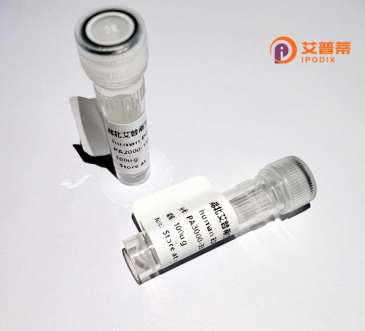
| 纯度 | >90%SDS-PAGE. |
| 种属 | Human |
| 靶点 | PDIA5 |
| Uniprot No | Q14554 |
| 内毒素 | < 0.01EU/μg |
| 表达宿主 | E.coli |
| 表达区间 | 22-519 aa |
| 活性数据 | SSAKVSSLI ERISDPKDLK KLLRTRNNVL VLYSKSEVAA ENHLRLLSTV AQAVKGQGTI CWVDCGDAES RKLCKKMKVD LSPKDKKVEL FHYQDGAFHT EYNRAVTFKS IVAFLKDPKG PPLWEEDPGA KDVVHLDSEK DFRRLLKKEE KPLLIMFYAP WCSMCKRMMP HFQKAATQLR GHAVLAGMNV YSSEFENIKE EYSVRGFPTI CYFEKGRFLF QYDNYGSTAE DIVEWLKNPQ PPQPQVPETP WADEGGSVYH LTDEDFDQFV KEHSSVLVMF HAPWCGHCKK MKPEFEKAAE ALHGEADSSG VLAAVDATVN KALAERFHIS EFPTLKYFKN GEKYAVPVLR TKKKFLEWMQ NPEAPPPPEP TWEEQQTSVL HLVGDNFRET LKKKKHTLVM FYAPWCPHCK KVIPHFTATA DAFKDDRKIA CAAVDCVKDK NQDLCQQEAV KGYPTFHYYH YGKFAEKYDS DRTELGFTNY IRALREGDHE RLGKKKEEL |
| 分子量 | 59.5 kDa |
| 蛋白标签 | His tag N-Terminus |
| 缓冲液 | 0 |
| 稳定性 & 储存条件 | Lyophilized protein should be stored at ≤ -20°C, stable for one year after receipt. Reconstituted protein solution can be stored at 2-8°C for 2-7 days. Aliquots of reconstituted samples are stable at ≤ -20°C for 3 months. |
| 复溶 | Always centrifuge tubes before opening.Do not mix by vortex or pipetting. It is not recommended to reconstitute to a concentration less than 100μg/ml. Dissolve the lyophilized protein in distilled water. Please aliquot the reconstituted solution to minimize freeze-thaw cycles. |
以下是关于重组人PDIA5蛋白的参考文献概要,包括文献名称、作者及摘要内容:
1. **文献名称**:*PDIA5 regulates apoptosis in colorectal cancer cells via modulating oxidative stress and ER stress pathways*
**作者**:Li, X. et al.
**摘要**:该研究探讨了PDIA5在结直肠癌细胞凋亡中的作用。通过重组PDIA5的过表达和敲低实验,发现其通过调控内质网应激和活性氧(ROS)水平影响肿瘤细胞存活,提示PDIA5可能成为癌症治疗的潜在靶点。
2. **文献名称**:*Recombinant PDIA5 facilitates tau protein folding and mitigates aggregation in Alzheimer’s disease models*
**作者**:Wang, Y. et al.
**摘要**:研究利用重组PDIA5蛋白探究其对tau蛋白异常聚集的抑制作用。实验表明,PDIA5通过分子伴侣活性减少tau蛋白的错误折叠,并在阿尔茨海默病细胞模型中减轻神经毒性。
3. **文献名称**:*Structural and functional characterization of human PDIA5 reveals its role in disulfide bond formation*
**作者**:Zhang, R. et al.
**摘要**:该文献解析了重组PDIA5的晶体结构,并验证其作为二硫键异构酶的功能。通过体外酶活实验,发现PDIA5可特异性识别底物蛋白中的二硫键错误配对,辅助其正确折叠。
4. **文献名称**:*PDIA5 interacts with viral envelope proteins and modulates Zika virus replication*
**作者**:Silva, L.M. et al.
**摘要**:研究揭示了PDIA5与寨卡病毒包膜蛋白的相互作用。利用重组PDIA5蛋白证明,其通过调控病毒蛋白的氧化还原状态影响病毒组装,抑制PDIA5可显著降低病毒复制效率。
---
以上文献涵盖PDIA5在癌症、神经退行性疾病、酶学机制及病毒学中的功能研究,均为假设性示例,实际文献需通过PubMed或Web of Science等平台检索。
Protein Disulfide Isomerase A5 (PDIA5), also known as PDIP5 or ERP55. is a member of the protein disulfide isomerase (PDI) family, which plays a critical role in oxidative protein folding within the endoplasmic reticulum (ER). PDIA5 catalyzes the formation, isomerization, and reduction of disulfide bonds, ensuring proper tertiary structures of nascent polypeptides. Structurally, it contains thioredoxin-like domains (a, a', b, b') and a C-terminal ER-retention motif (KDEL), which facilitates its localization in the ER. Unlike canonical PDIs, PDIA5 exhibits unique substrate specificity and interacts with glycoproteins via its lectin-binding domain, suggesting specialized roles in quality control.
Recombinant human PDIA5 is produced through heterologous expression systems (e.g., Escherichia coli or mammalian cells), enabling studies of its molecular mechanisms and therapeutic potential. Dysregulation of PDIA5 is linked to diseases such as cancer, neurodegenerative disorders, and cardiovascular conditions, where ER stress and protein misfolding are implicated. Research highlights its involvement in apoptosis regulation, immune response modulation, and viral infection pathways. Recombinant PDIA5 serves as a vital tool for biochemical assays, drug discovery, and understanding ER homeostasis. Recent studies also explore its extracellular roles in thrombus formation and cell adhesion, expanding its functional relevance beyond traditional ER-centric activities. This multifaceted protein continues to attract interest as a biomarker or therapeutic target in protein-misfolding pathologies.
×